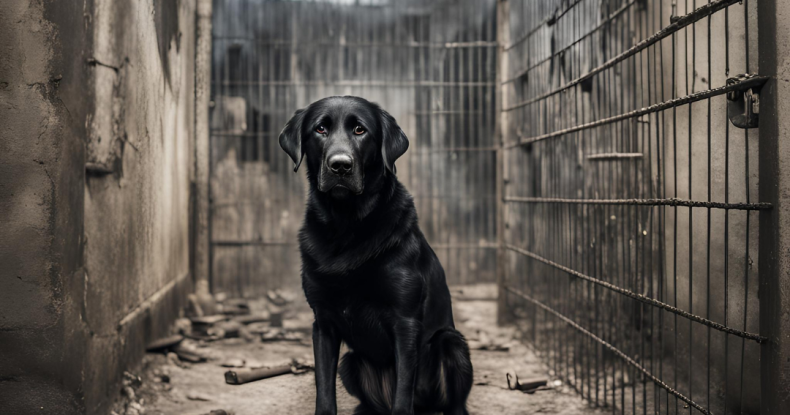I’m thrilled to see you’re still with us!
Your continued interest means the world to me because, quite frankly, I’m determined to engage only with folks who share my values of empathy and understanding, so it’s refreshing to know we’re on the same page, and I’m hopeful that should our paths cross one day, we’ll get along just fine.
Today, I want to share a story close to my heart.
A tale that has left an indelible mark on my approach to dog training and ethical practices. But before I dive in, I want to assure you that while this story isn’t about Titon or any of my own dogs, its significance is just as profound.
Let me introduce you to Bailey, an elderly black Labrador cross, who crossed my path several years ago.
Bailey’s journey was a testament to his resilience, but it was also a stark reminder of the profound impact of neglect and cruelty, that humans (pretending to be dog trainers) can have.
Rescued from a neglectful situation, Bailey arrived at the boarding kennels carrying deep scars from his past.
His anxiety was palpable, manifesting in physical ailments that made every step a challenge for him.
What struck me most about Bailey was his gentle spirit despite his traumatic past.
He carried himself with a quiet dignity, but his eyes betrayed a deep-seated fear and uncertainty in the world around him.
It was evident that he had been through hell and back just looking at him, yet there was still a glimmer of hope in his soul, each and every time he experienced the outdoors.
A spark that refused to be extinguished.
As I cared for Bailey, I was overwhelmed by conflicting emotions.
On one hand, there was an outpouring of love and compassion for this sweet soul who had endured so much pain and neglect at the hands of a human.
And on the other hand, there was an indescribable fury towards those responsible for his suffering. A fury that threatened to consume me at times.
Bailey had been severely subjected to the improper use of an electric collar and had, to put it bluntly, been zapped to brain damage.
Not to mention the beatings he had incurred. His neck and head were always twisted from injury and shock collar damage and he suffered with pain in his body that made it difficult for him to walk.
He was a truly abused and neglected dog in his early years, until thankfully, he found his forever loving home with his current owners where he was able to live out his life in comfort surrounded by those who loved him, despite his ailments and issues.
Amidst the turmoil life had thrown at him, Bailey taught me invaluable lessons about patience, empathy, and recovering resilience.
Despite his struggles, he showed an unwavering determination to keep moving forward, all be it one hesitant step at a time.
Each interaction with Bailey reinforced my commitment to providing dogs with the love, care, and respect they deserve.
It also underscored the importance of ethical training methods that prioritise the dogs well-being above all else.
Bailey’s story serves as a poignant reminder of the resilience of the canine spirit and the transformative power that love and understanding can have on a dogs rehabilitation.
Bailey, and many others, would have been well within their rights to never trust another human being again, but he did… and that’s testament to the dogs tolerance and resilient nature, living along side us.
His legacy continues to shape my approach to training and ethics every day.
I trust that Bailey’s story strikes a chord with you as profoundly as it does with me.
While I know you’d never intentionally harm or endanger your dog, it’s crucial to remain vigilant of those who claim to possess a quick-fix solution to your challenges.
I understand the desperation that comes with living alongside a reactive dog. Truly I do. It can be incredibly disheartening and overwhelming.
However, the false promises and misleading marketing tactics employed by some individuals can have long-lasting and detrimental consequences to you and your dog.
So, please don’t fall for them.
Reactivity is often behavioural rehabilitation (it’s not dog training and not everybody can do it as successfully as they proclaim too).
You also need to know that sometimes, some things can’t be truly fixed.
It really depends on the severity of the dog and how far management can take them.
I’ll share more about that side of things in tomorrows email for you, to help you get a better understanding of where you own dog might be at with their behaviour.
Stay tuned for more insights, stories, and valuable tips in the days ahead.
Thanks to all who’ve shared their dogs stories with me too (I’m reading them all!)
And as always, if you have any questions or topics you’d like me to cover, don’t hesitate to reach out.
Wishing you and your furry friends a wonderful day ahead
Speak soon,
Claire Lawrence
Head Dog Trainer for Reactive Dogs
P.S. If you missed any of our previous emails or want to catch up on past content, you can find them all within this blog
